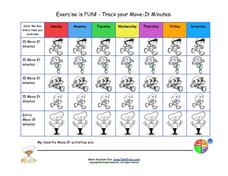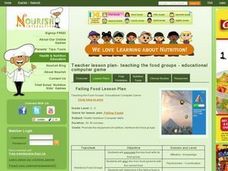Curated OER
Economics
Fourth graders read a poem about rice and identify its importance around the world. In this rice lesson, 4th graders read about the role of rice in various nutritional sectors around the world. Students complete two word problems about...
Curated OER
Food Pyramid Nutrition Puzzles
Students put together food group puzzles on the computer and identify the healthy message in the end. In this food lesson plan, students identify the food group that the puzzle is representing as well.
Curated OER
Healthy You
Students navigate through various sites to find nutrition information to help make healthy choices and decisions. They find the answers by searching each site. The assignment should be turned into the teacher through a word document via...
Baylor College
What's Is Soil Made Of?
It's time to roll up those sleeves and get a little dirty in the second instructional activity of this series on the science of food. Investigate where plants and animals get the minerals they need to live in this two-part exploration of...
Baylor College
They're Everywhere: Bacteria
Totally gross out your class with the eighth lesson in this series on food science. Explore the microscopic world of bacteria by taking swabs of different classroom objects and growing colonies in petri dishes. An engaging activity that...
Baylor College
What's That Food?
Get things cooking with the first lesson in this series on the science of food. Working in small groups, young scientists make and record observations about different mystery foods. These descriptions are then shared with the class and...
Lincoln Public Schools
Cereal Box Project
Challenge your class with this fun and engaging engineering design project. The goal, to create a brand new cereal complete with a list of ingredients, a name and logo, and a box to hold it in. Starting with a survey to determine the...
Inside Mathematics
Number Towers
Number towers use addition or multiplication to ensure each level is equal. While this is common in factoring, it is often not used with algebraic equations. Solving these six questions relies on problem solving skills and being able to...
Pecentral.org
Personal Wellness Inventory
How healthy are you really? High schoolers assess the aspects of physical, mental, and social health in their lives before applying them to various templates and discerning the unhealthy habits that they can work on changing.
Nuffield Foundation
How Much Energy Is There in Food?
People associate calories with food, but what is a calorie? Young scientists measure the number of calories in samples of food to better understand the concept. They test a variety of samples, take measurements, and compare their results...
Curated OER
Exercise is Fun! - Track Your Move-It Minutes
Get your class up and moving with a fun exercise tracking chart. Kids will be able to see just how much exercise they get in a single week as they color in the grid to indicate how much they moved each day. The grid provides five boxes...
Curated OER
Quinoa Pasta 3
A mixture of quinoa and corn is for dinner in this collaborative task that sets up nicely as a system of linear equations. Your supper guests discuss numerical precision and percentages as they formulate a plan of how to solve the problem.
Curated OER
Quinoa Pasta 2
Learners discover that a system of linear equations models this mixture of quinoa and corn in a collaborative task. Your learners receive all the relevant information in this second of three variants of tasks that ask them to find the...
PBS
Heart to Heart
Study heart health and math in one activity. After measuring their resting heart rates by finding the pulse in their wrists, learners build a stethoscope to listen to their heart rate, and note the differences between the two methods.
Curated OER
An Exploration of Cradle-to-Cradle Design Thinking
Introduce cradle-to-cradle design thinking. Scholars first discuss the importance of natural laws and rights. They then use a variety of online and print resources to research eco-efficiency and cradle-to-cradle design.
Curated OER
Falling Food Lesson
Pupils examine personal health by defining the five food groups. In this food pyramid lesson, students discuss the importance of each food group and write them on the board. Pupils utilize the Internet to participate in a food...
Curated OER
A Well Balanced Meal
Learners are given paper plates and pictures of food. They are to glue the foods they would eat that would make a balanced meal.
Curated OER
Nick News Lesson Plan
Students examine the connection between good health and physical activities. They watch a video, discuss physical fitness, and develop a plan for lifelong health.
Curated OER
Fishing for Foods
Students practice using the food pyramid and know which food group familiar foods belong in.
Curated OER
Sometimes and All the Time Foods
Students recognize a wide variety of fruit and have a greater understanding about the importance of fruit in their diet, and determine that some fruits' skins are edible and others are not.
Curated OER
Why is rice important?
Second graders examine why rice is so important to the world. In this agriculture lesson, 2nd graders discover the origins of rice farming. Students study how many countries depend on rice for survival. Students research countries and...
Curated OER
Developing Civilizations and the Role of Rice
Student investigate how civilizations developed. In this rice farming lesson, 5th graders explore how rice cultivation changed through different civilizations. Students gain knowledge about different types of rice, where it's grown and...
Curated OER
Eat A Rainbow!
Learners demonstrate the importance of eating fruits and vegetables. In this nutrition lesson, students identify and sort different fruits and vegetables by colors. Learners list reasons why eating fruits and vegetables are important and...
Curated OER
The Food Pyramid
Students determine that humans need food to function properly. In this nutrition lesson plan, students discuss the food categories used in the food pyramid by charting the foods eaten in one day.

























